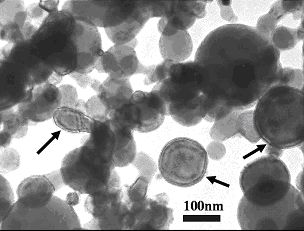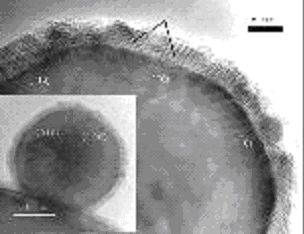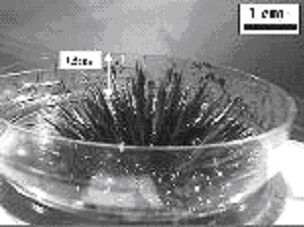Novel Properties of Metallic Nanoparticles and composites
Giant Hall Effect from embedded nanoparticles
At the Physics Department of HKUST, a group of scientists have discovered a large increase in Hall response in magnetic metal/insulator nanocomposites, Fe-SiO2, Ni-SiO2 and Co-SiO2, when the metal concentration is just enough to form a connected network (the percolation threshold). It has been also demonstrated by studying the non-magnetic Cu-SiO2nanocomposites that the Giant Hall effect can be ascribed to the local quantum interference effect (Phys. Rev. Lett. 86, 5562 (2001)).


Oxidation/corrosion resistant nanoparticles of Fe and their ferrofluid
Passivated nanocrystals of iron prepared by gas condensation of plasma evaporated vapor in Tianjin University are remarkably resistant to further oxidation and corrosion. We have shown by electron diffraction and high resolution transmission electron microscopy that each nanocrystal of Fe is enclosed by a shell of single crystal-like epitaxial gamma-Fe2O3 oxide (Fig 1 and Fig. 2). The passive oxide shell is about 4 nm thick. This is thick enough to provide effective protection to the metal core at room temperature (Appl. Phys. Lett. 77, 3971 (2000)).
Ferrofluid has been fabricated with these corrosion resistant nanocrystals of iron. As shown in Fig. 3, when the ferrofluid is subjected to the non-uniform magnetic field of a NdFeB permanent magnet, it transforms into a solid with long and sharp spikes.

Discovery of magnetic refrigeration materials
Anisotropic magnetocaloric effects have been observed experimentally for the first time by using the identical anisotropic magnetic Fe8 clusters, which has been intensively studied for the Resonant Quantum tunnelling of Spins. It is also interesting to examine the anisotropy effect using this model system, because the nano-structured magnetic materials usually show a strong magnetic anisotropy (Phys. Rev. Lett. 87, 157203 (2001). Due to the simple form of the Hamiltonian in the system, the dynamics of the magnetic moments can be strictly obtained using quantum mechanics. The quantum mechanical solution agrees excellently with the experimental results.
Rare-earth based, inter-metallic alloys have been synthesized and characterized for the search of magnetic refrigeration materials used for Active Magnetic Regenerator Magnetic Refrigerator (AMR). LaFe12-xSix alloys with a NaZn13 type cubic structure have been discovered to be a good material candidate for AMR in the temperature range -70 degrees Celsius to room temperature (Appl. Phys. Lett. 77, 3072 (2000)).